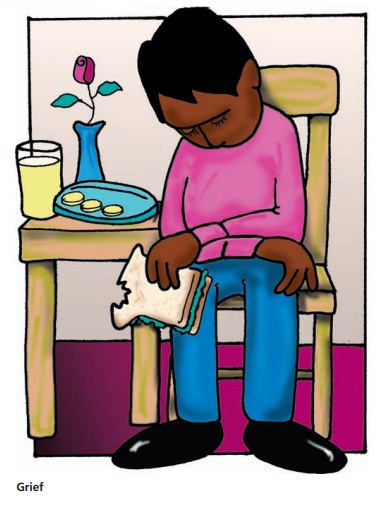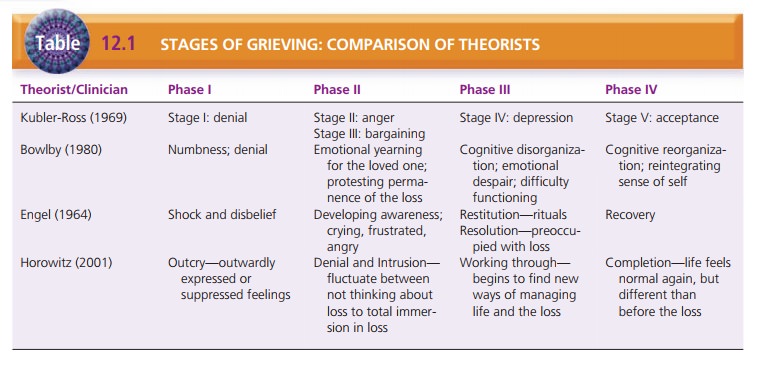Chapter: Psychiatric Mental Health Nursing : Grief and Loss
Theories of Grieving
Theories of Grieving
Among well-known theories of
grieving are those posed by Elizabeth Kubler-Ross, John Bowlby, George
Engel, and Mardi Horowitz.

Kubler-Ross’s Stages of Grieving
Elisabeth Kubler-Ross (1969) established a basis for under-standing
how loss affects human life. As she attended to clients with terminal
illnesses, a process of dying became apparent to her. Through her observations
and work with dying clients and their families, Kubler-Ross developed a model
of five stages to explain what people experience as they grieve and mourn:
·
Denial is shock and disbelief
regarding the loss.
·
Anger may be expressed toward God,
relatives, friends, or health care
providers.
·
Bargaining occurs when the person asks
God or fate for more time to delay
the inevitable loss.
·
Depression results when awareness of the
loss becomes acute.
·
Acceptance occurs when the person shows
evidence of coming to terms with
death.
This model became a prototype for care providers as they looked for
ways to understand and assist their clients in the grieving process.
Bowlby’s Phases of Grieving
John Bowlby, a British psychoanalyst, proposed a theory that humans
instinctively attain and retain affectional bonds with significant others
through attachment behav-iors. These
attachment behaviors are crucial to the development
of a sense of security and survival. People experience the most intense
emotions when forming a bond such as
falling in love, maintaining a bond
such as loving someone, disrupting a
bond such as in a divorce, and renewing
an attachment such as resolving a conflict or renewing a relationship (Bowlby,
1980). An attach-ment that is maintained is a source of security; an
attach-ment that is renewed is a source of joy. When a bond is threatened or
broken, however, the person responds with anxiety, protest, and anger.
Bowlby described the grieving process as having four phases:
·
Experiencing numbness and denying the loss
·
Emotionally yearning for the lost loved one and pro-testing the
permanence of the loss
·
Experiencing cognitive disorganization and emotional despair with
difficulty functioning in the everyday world
·
Reorganizing and reintegrating the sense of self to pull life back
together.
Engel’s Stages of Grieving
George Engel (1964) described five stages of grieving as follows:
·
Shock and disbelief: The initial reaction to a
loss is a stunned, numb feeling
accompanied by refusal to ac-knowledge the reality of the loss in an attempt to
pro-tect the self against overwhelming stress.
·
Developing awareness: As the individual begins to
ac-knowledge the loss, there may be crying, feelings of helplessness,
frustration, despair and anger that can be directed at self or others,
including God or the deceased person.
·
Restitution: Participation in the rituals
associated with death, such as a
funeral, wake, family gathering, or religious ceremonies that help the
individual accept the reality of the loss and begin the recovery process.
·
Resolution of the loss: The individual is preoccupied with the loss, the lost person or
object is idealized, the mourner may even imitate the lost person. Eventually,
the preoccupation decreases, usually in a year or per-haps more.
·
Recovery: The previous preoccupation
and obsession ends, and the individual
is able to go on with life in a way that encompasses the loss.
Horowitz’s Stages of Loss and Adaptation
Mardi Horowitz (2001) divides normal grief into four stages of loss
and adaptation:
·
Outcry: First realization of the loss. Outcry may be out-ward, expressed by
screaming, yelling, crying, or col-lapse. Outcry feeling can also be suppressed
as the person appears stoic, trying to maintain emotional con-trol. Either way,
outcry feelings take a great deal of energy to sustain and tend to be short-lived.
·
Denial and intrusion: People move back and forth
dur-ing this stage between denial and intrusion. During de-nial, the person
becomes so distracted or involved in activities that he or she sometimes isn’t
thinking about the loss. At other times, the loss and all it represents
intrudes into every moment and activity, and feelings are quite intense again.
Working through: As time passes, the person
spends less time bouncing back and
forth between denial andintrusion, and the emotions are not as intense and
over-whelming. The person still thinks about the loss, but also begins to find
new ways of managing life after loss.
·
Completion: Life begins to feel “normal”
again, although life is different
after the loss. Memories are less painful and don’t regularly interfere with
day-to-day life. Epi-sodes of intense feelings may occur, especially around
anniversary dates, but are transient in nature.
Table 12.1 compares the stages of grieving theories.

Related Topics